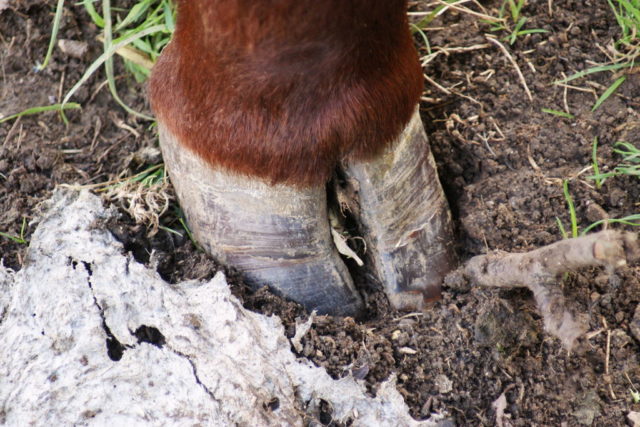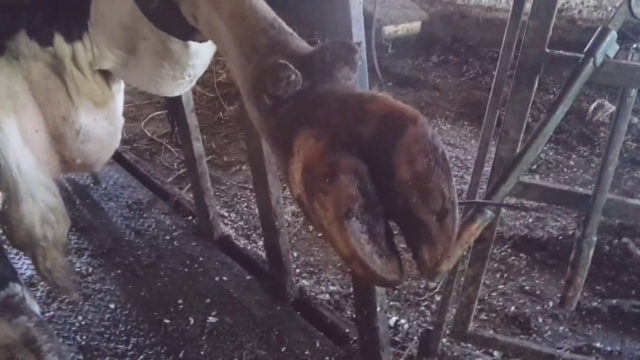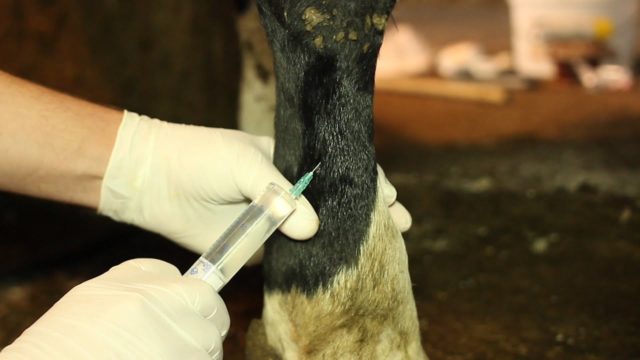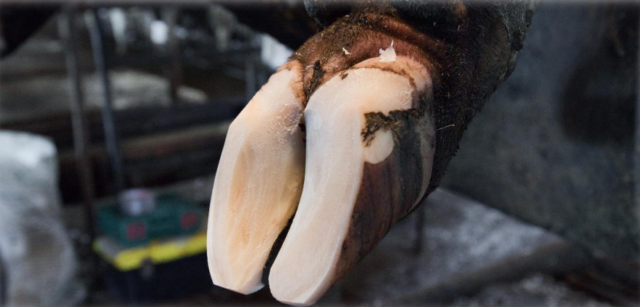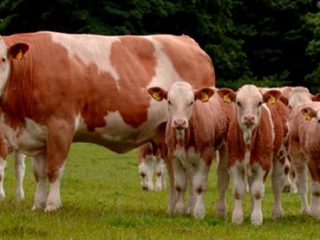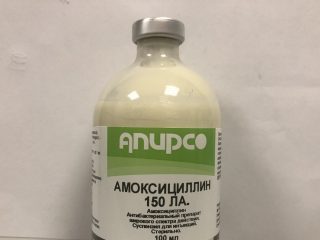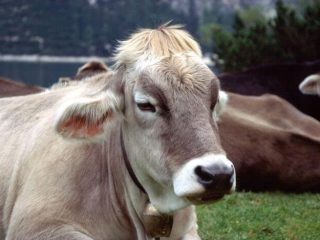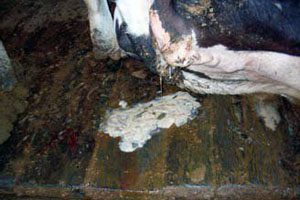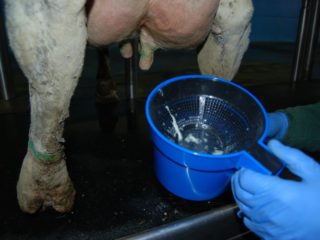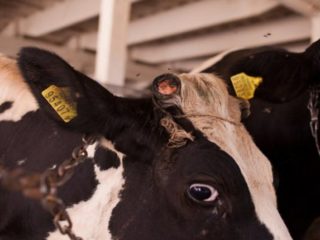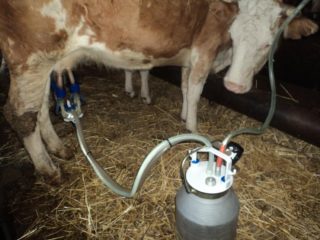Content
Laminitis in cows is a diffuse aseptic inflammatory process of the dermis of the claw. This disease is multifactorial; it is based on many causes of development. The disease in cattle can occur in subclinical, acute and chronic forms. The most common type of laminitis is subclinical. This is the main cause of lameness in cows. The disease develops gradually and sometimes manifests itself to its full extent, when the animal can no longer step on the limb and the wound becomes visible.
Causes of laminitis in cattle
The hoof is a modified skin that forms a cover of the keratinized layer of the epidermis next to the third and fourth phalanges. The hoof consists of a border, a corolla, a wall, a crumb and a sole. With laminitis, the layer of sheets between the shoe and the coffin bone becomes inflamed. Inflammation is characterized by excessive accumulation of fluid under the skin in the soft tissues.
Often the disease occurs as a complication of rumen acidosis, which occurs in a chronic form after regular feeding of low-quality feed in combination with starchy grain concentrates. In this case, carbohydrates are fermented to form acids.The internal environment of the preventricles begins to secrete toxins and becomes unsuitable for proper microflora. Metabolites penetrate the skin through the bloodstream, reach the base of the hoof and cause tissue inflammation.
In addition to these reasons for the development of laminitis in cows, the factors that provoke inflammation include the following:
- the floor surface is too hard, in which the load on the hoof is not distributed evenly;
- lack of daily exercise;
- poor quality hoof care;
- deficiency of carotene (a vitamin necessary for the skin of a cow);
- high humidity in the barn;
- irregular manure removal;
- weakened animal immunity, vitamin deficiency;
- suffered complex diseases;
- calving, postpartum period;
- physical overload of the cow (long drive);
- monotonous feeding diet;
- stressful situations (transportation);
- hypothermia.
Symptoms of hoof laminitis
One of the main symptoms indicating a problem with a cow’s hoof is lameness of the animal. After its appearance, it is necessary to examine the individual’s hooves, thoroughly cleaning them before the procedure. Next, the livestock breeder needs to carefully examine the color of the horny tissue, skin, and check the hooves for erosion and damage.
Other symptoms of laminitis in cows include:
- the animal prefers to lie down and has difficulty getting up;
- when moving, stiffness is noticeable, the cow flaps its limbs, minces;
- muscle tension and trembling;
- swelling of the crumb and corolla;
- local increase in temperature, rapid pulse;
- possible detachment of the horny covering of the hoof;
- pain on palpation;
- hoof deformation;
- with severe pain there is no appetite;
- reduction in milk production, possibly complete cessation of milk production.
Laminitis in cows most often affects the pelvic limbs. At the same time, the animal bends its back, trying to adjust its limbs to suit itself. She moves the front hooves back, reducing the load on the hind hooves.
Forms and course of the disease
Laminitis occurs in cows according to the degree of damage. This disease is characterized by several forms of development: acute and chronic.
Acute laminitis in a cow is determined by rapid pulse, slight trembling, sweating and impaired milk production. The sick individual lies down and has difficulty getting up. When palpating the hoof, a painful reaction is observed. General weakness of the cow and clouding of the eyes are noted.
Chronic laminitis develops if the cause of the disease has a long-term effect or the acute form of the disease is constantly repeated. The chronic course of laminitis is characterized by significant hoof deformation. Its end is square and has a rough surface. The bone of the third finger is displaced and compresses the skin of the corolla. The tissues located above it are lowered, and a certain dent forms there. When cleaning the hoof, bruising is observed in the sole of the shoe. When the horn delaminates, two soles are formed. The junctions with the walls also bleed. Vascular changes indicate impaired blood circulation in the horn-forming tissue.
Another type of laminitis in cows is the subclinical form of the disease.Its peculiarity is that there are no clinical signs of pathology. However, blood-yellow markings are visible on the hoof horn. Subclinical laminitis is the cause of the development of many other hoof diseases, such as heel horn erosion and sole ulcers.
Diagnostics
To make a correct diagnosis, it is necessary to examine the dorsal and abaxial wall of the hoof by palpation and percussion. These diagnostic methods use hoof forceps and a hammer. This is how the local temperature of the hooves, tension, soreness in the area of the corolla and interdigital gap are determined, and the pulsation of the digital arteries is determined, which indicates the onset of inflammation in the tissues.
Hoof forceps are used to identify the localization of the pathological process in the area of the sole, walls, and crumb. When tapped, the cow withdraws the limb. Based on the change in sound, an empty wall or horn column is established.
A photo is taken of a cow with a questionable diagnosis. To conduct an X-ray examination, it is necessary to properly restrain the cow. To do this, the animal is placed on boards. Paint is applied to the toe part of the hoof wall along the sole - a special X-ray marker, then a picture is taken from a side angle.
Treatment of laminitis in cows
Treatment of laminitis in cattle is aimed at eliminating the factors that caused the disease. Next, you should take care of soft bedding for the cow, and also provide her with complete rest. The following measures can help get rid of laminitis:
- balanced diet;
- limiting water consumption;
- cold clay compresses;
- cleaning the cow's hoof, giving it the correct shape;
- treatment with disinfectant solutions (hydrogen peroxide, furacillin);
- application of wound healing ointments;
- dressing the hoof until the wound heals.
You should also use general strengthening drugs to boost immunity. Symptomatic treatment includes antipyretics and painkillers. For large lesions and severe pain, antibiotic therapy is prescribed, and novocaine blockade is used.
For chronic laminitis in cows, conservative treatment is ineffective. In this case, the animal must be culled.
Is it possible to fix hooves after laminitis?
After all necessary therapeutic measures have been taken to eliminate laminitis, the cow should have her hooves adjusted every 2-3 months. Before pruning, you need to evaluate their appearance. The procedure is not performed for inflammatory processes and hoof injuries.
For trimming you will need the following tool:
- professional hoof knives;
- cutter;
- hoof forceps;
- scissors;
- cow restraining machine;
- disinfectants in case of injury.
The day before the procedure, the cow is transferred to a damp bedding so that the upper stratum corneum softens somewhat. It is necessary to prepare and disinfect instruments in advance. If necessary, sedatives can be administered.
Work begins with trimming the forelimbs. The hand should move from the inner layer to the keratinized tissue. You can use scissors to remove clumps of fur. A model of the hooves is made with a knife, the sharp edges are rounded off with a file. Movements must be careful not to damage the inner layer of the claw and aggravate the situation.
To determine whether the procedure was performed correctly, there is a special test. It helps identify the presence of an angle between the sole and the front of the hoof.
Disease prevention
Preventive measures aimed at preventing the occurrence of laminitis in cows include:
- daily inspection of the cow’s limbs after exercise;
- regular hoof trimming;
- baths once every 3 days to cleanse and disinfect;
- a complete diet;
- vitamins and microelements in feed;
- careful change of diet;
- daily active exercise.
It is important to follow all the necessary sanitary and hygienic rules for keeping cows. You should promptly remove contaminated bedding, check it for the presence of foreign traumatic objects that can injure the cow’s limb, and repair the floor covering if necessary.
Conclusion
Laminitis in cows often occurs due to improper care, maintenance and feeding of cattle. It is possible to fight this disease; the prognosis for acute laminitis is favorable. However, in some forms of the disease, the pathology can go undetected for a long time, so it is important to conduct a daily inspection of the limbs and promptly clean the hooves.
